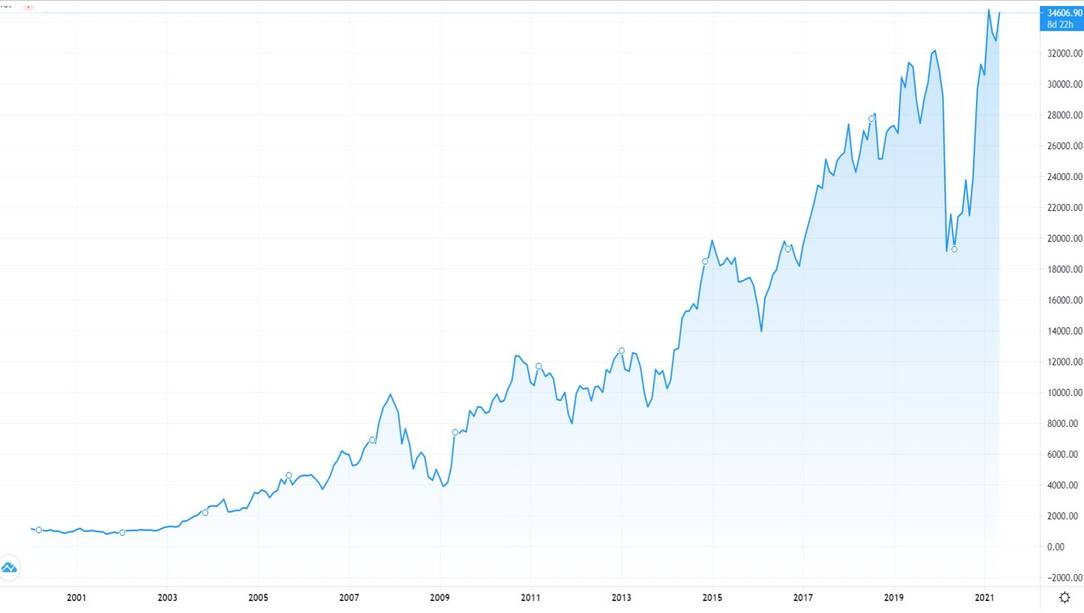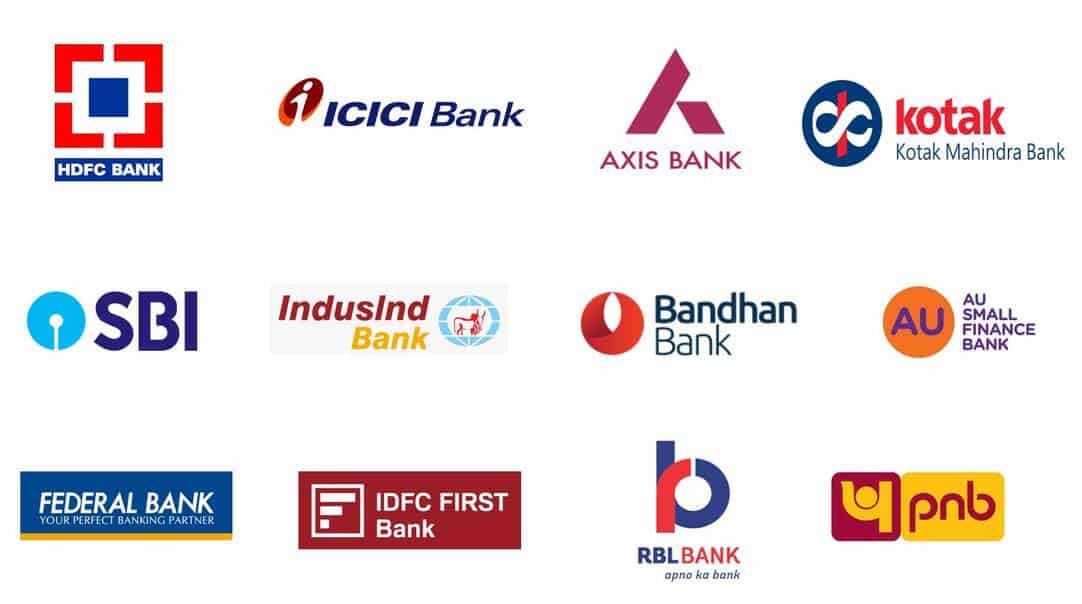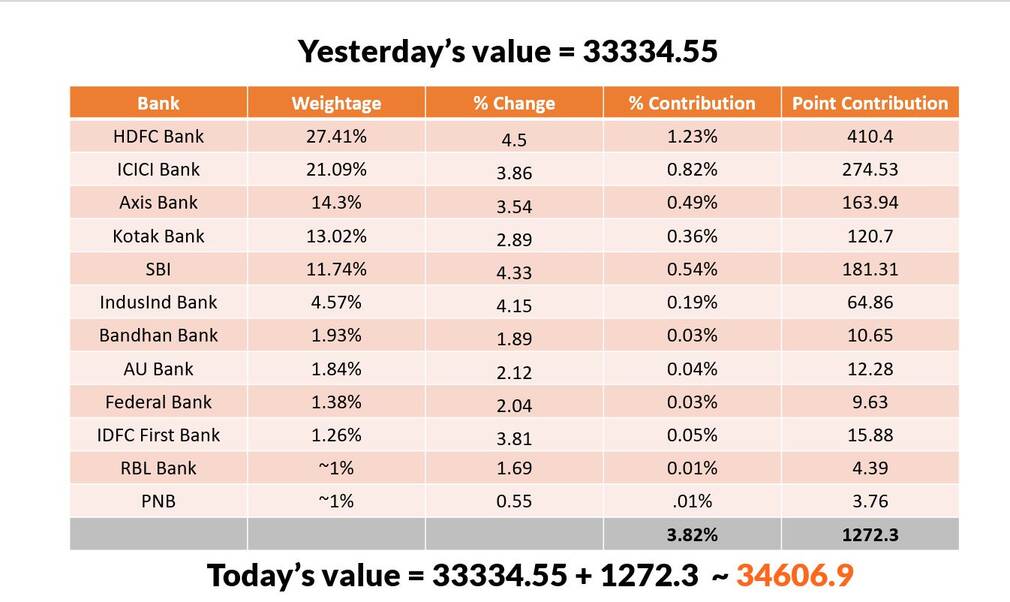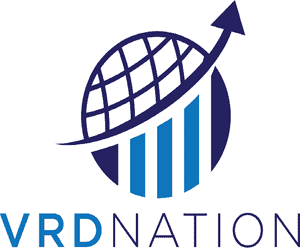What is Bank Nifty
Bank Nifty is an index that tracks the performance of the banking stocks ..plain and simple…there is no special magic in it….it tells us if the banking stocks are moving up or down.
Just because it is simple doesn’t mean it is not significant.
Think of it like this..
If someone asks you how the Indian banking sector is performing what would you do? Will you go to check each banking stock and see how they are performing? That would require a lot of time and effort and it is not easy to consolidate and make sense of that information also, right?
Instead of checking each banking stock, we can just look at how the index is performing.
For example, here, we can look at the history of 20 years of how the banking sector has performed by just looking at the chart of Bank Nifty…..isn’t it awesome? So much information at one place.
Look at how well the banking stocks have done … from 5k in 2006, it went up 7 times, to 35k. The journey got a little bumpy during the Covid crisis but it is getting back on track right.
So, you see how easy it is to track the performance of the banking sector?
Who created Bank Nifty?
Someone must have come up with the idea, right?
Well, National Stock Exchange did.
They created Bank Nifty to track the performance of well-established banking stocks.
Not just banks, NSE has created indices for all the key sectors such as Pharma, IT, Metals, Auto and of course they have broader market indices such as Nifty and Nifty Midcap as well.
With the help of these indices, investors such as you and I can easily check how these individual sectors are performing.
Why is Bank Nifty is so popular? Why do we hear so much about Bank Nifty but not much about pharma or IT index? What’s so special about bank nifty?
Well, there is a very good reason for that and I will come to that later in the video.
First, let us understand some of the basics.
Which companies are included in this index?
Bank Nifty comprises of these 12 banking companies. I am sure you know most of them.
There are hundreds of banking companies in India-why select only 12?
Well, there are 2 reasons.
- Not every bank in India is listed on the Stock Exchanges and if a stock is not listed on the exchange, its price-performance cannot be tracked and so that is one practical reason why every bank is not part of the index. However, not all the listed banking companies are part of the index. Banks such as Union Bank, IDBI Bank, Maharashtra Bank, Central bank of India are listed but are not part of the index.
- Only the best performing, market-leading, banking companies are included in the index
So, NSE says that we will only include the best and the brightest of the banking stocks in this index,
By the way, once you are part of Bank Nifty, it doesn’t guarantee their place permanently. If a bank starts to underperform, NSE moves it out of Bank Nifty and replaces it with a better performing bank.
This is what happened with Yes Bank. When it started to go down the hill, NSE moved it out of Bank Nifty and later it added better performing stocks such as Bandhan Bank and AU Bank.
So, as you can see, it is cut-throat competition and only the best can stay in this top 12 list.
This process of reviewing the performance of all the index constituents is called index rebalancing and NSE does that every 6 months.
Now, let’s understand a very important concept.
How is Bank Nifty actually calculated?
So, we know that these 12 stocks are used to calculate but what exactly is the calculation behind that? Right now, Bank Nifty is at 35000. How does NSE arrive at that number? Do we just add the stock prices of these stocks, multiply them, divide them….what exactly happens here?
So, for understanding that, we need to know that for any index there is a Base date and a Base value. The Base date means the first date from which that index has been tracked and the Base value means the value which was assigned to the index on that date.
For Bank Nifty, NSE chose the base date as 1st Jan 2000 and its base value as 1000.
NSE said that on the 1st of Jan 2000, when they started tracking this index, the value of Bank Nifty was set as 1000.
It could have been any number, but usually, exchanges choose an easy round number.
From that date onwards, NSE calculated the value of Bank Nifty based on changes in prices of the 12 banking companies that are part of Bank Nifty.
Not every bank has the same weightage -bigger companies such as HDFC Bank have a higher weightage whereas smaller companies like PNB or RBL Bank have a lower weightage. This weightage is decided based on a methodology called the free-float market capitalization method.
Please watch the video on the top of this page to understand the exact calculation.
Ok, now, moving on…
How frequently is Bank Nifty calculated?
The value of Bank Nifty is calculated in real-time.
Every second, in fact, every fraction of a second, there is a price change in any of the 12 stocks, the price of Bank Nifty changes and you can see that from your broker’s terminal.
What is happening is that NSE is calculating the price of Bank Nifty based on the changes in the stock prices in real-time.
Ok, now, switching gears…let me answer a very common question that beginners ask.
Can we buy shares of Bank Nifty?
It is a very obvious question, especially after seeing that Bank Nifty has given 800% returns over the last 15 years.
The thing to understand here is that Bank Nifty is an index -it is not a stock, it is not a company.
While I can buy shares of HDFC Bank or shares of ICICI bank, I can not buy any shares of Bank Nifty because it is not a company and it is just a calculated value.
But don’t worry there is a solution to every problem.
Although we cannot directly buy shares of Bank Nifty, we can invest in index mutual funds and ETFs that follow Bank Nifty as their benchmark index.
For these index funds, their only job is to mirror Bank Nifty. They buy the same stocks and in the same proportion as Bank Nifty and essentially give you similar kinds of returns like bank Nifty, a little bit here and there but mostly similar.
A lot of portfolio investors do that and you can explore some of these funds here:
Ok, so far, we talked about all the mechanical stuff but remember I said earlier Bank Nifty is much more popular for a reason.
The reason it is so much more popular than other sectoral indices is that we can trade Bank Nifty. We can not trade other indices such as Nifty Pharma, Nifty IT, Nifty Metal, Nifty Auto but we can trade Bank Nifty.
That brings us to the next question.
How can we trade in Bank Nifty?
There are 2 ways we can trade Bank Nifty- either through futures or options.
If you’re bullish on Bank Nifty, you can buy its future and if you are bearish, you can short or sell the future.
The most exciting aspect of trading in bank Nifty or Nifty for that matter is options because you can build hundreds of strategies. There is a whole world of options that we will discuss in subsequent videos.
Bank Nifty is the darling of active traders including myself and as I mentioned earlier, I trade Bank Nifty regularly.
There are tons of ways to trade in Bank Nifty, but I think the real question is should we be trading in Bank Nifty? Well, that’s where my love and hate relation aspect comes in.
Let me not get personal and just wrap up this article with 3 very important points about Bank Nifty.
Important points to note
- 90% of private banks
- HDFC Bank is the king
- Very volatile index
Useful website
Last but not least, here is a very useful website if you want to explore more about Bank Nifty or any other index for that matter.
nseindices.com
It is NSE’s official website for indices so you can trust the data there.
Howdy!
If you’re here for the first time, let’s get introduced.
VRD Nation is India’s premier stock market training institute and we (Team VRD Nation) are passionate about teaching each and every aspect of investing and trading.
If you’re here for the first time, don’t forget to check out “Free Training” section where we have tons of free videos and articles to kick start your stock market journey.
Also, we got two awesome YouTube channels where you can continue the learning process.
Must-Read Articles
What is Bank Nifty
Bank Nifty is an index that tracks the performance of the banking stocks ..plain and simple…there is no special magic in it….it tells us if the banking stocks are moving up or down.
Just because it is simple doesn’t mean it is not significant.
Think of it like this..
If someone asks you how the Indian banking sector is performing what would you do? Will you go to check each banking stock and see how they are performing? That would require a lot of time and effort and it is not easy to consolidate and make sense of that information also, right?
Instead of checking each banking stock, we can just look at how the index is performing.
For example, here, we can look at the history of 20 years of how the banking sector has performed by just looking at the chart of Bank Nifty…..isn’t it awesome? So much information at one place.
Look at how well the banking stocks have done … from 5k in 2006, it went up 7 times, to 35k. The journey got a little bumpy during the Covid crisis but it is getting back on track right.
So, you see how easy it is to track the performance of the banking sector?
Who created Bank Nifty?
Someone must have come up with the idea, right?
Well, National Stock Exchange did.
They created Bank Nifty to track the performance of well-established banking stocks.
Not just banks, NSE has created indices for all the key sectors such as Pharma, IT, Metals, Auto and of course they have broader market indices such as Nifty and Nifty Midcap as well.
With the help of these indices, investors such as you and I can easily check how these individual sectors are performing.
Why is Bank Nifty is so popular? Why do we hear so much about Bank Nifty but not much about pharma or IT index? What’s so special about bank nifty?
Well, there is a very good reason for that and I will come to that later in the video.
First, let us understand some of the basics.
Which companies are included in this index?
Bank Nifty comprises of these 12 banking companies. I am sure you know most of them.
There are hundreds of banking companies in India-why select only 12?
Well, there are 2 reasons.
- Not every bank in India is listed on the Stock Exchanges and if a stock is not listed on the exchange, its price-performance cannot be tracked and so that is one practical reason why every bank is not part of the index. However, not all the listed banking companies are part of the index. Banks such as Union Bank, IDBI Bank, Maharashtra Bank, Central bank of India are listed but are not part of the index.
- Only the best performing, market-leading, banking companies are included in the index
So, NSE says that we will only include the best and the brightest of the banking stocks in this index,
By the way, once you are part of Bank Nifty, it doesn’t guarantee their place permanently. If a bank starts to underperform, NSE moves it out of Bank Nifty and replaces it with a better performing bank.
This is what happened with Yes Bank. When it started to go down the hill, NSE moved it out of Bank Nifty and later it added better performing stocks such as Bandhan Bank and AU Bank.
So, as you can see, it is cut-throat competition and only the best can stay in this top 12 list.
This process of reviewing the performance of all the index constituents is called index rebalancing and NSE does that every 6 months.
Now, let’s understand a very important concept.
How is Bank Nifty actually calculated?
So, we know that these 12 stocks are used to calculate but what exactly is the calculation behind that? Right now, Bank Nifty is at 35000. How does NSE arrive at that number? Do we just add the stock prices of these stocks, multiply them, divide them….what exactly happens here?
So, for understanding that, we need to know that for any index there is a Base date and a Base value. The Base date means the first date from which that index has been tracked and the Base value means the value which was assigned to the index on that date.
For Bank Nifty, NSE chose the base date as 1st Jan 2000 and its base value as 1000.
NSE said that on the 1st of Jan 2000, when they started tracking this index, the value of Bank Nifty was set as 1000.
It could have been any number, but usually, exchanges choose an easy round number.
From that date onwards, NSE calculated the value of Bank Nifty based on changes in prices of the 12 banking companies that are part of Bank Nifty.
Not every bank has the same weightage -bigger companies such as HDFC Bank have a higher weightage whereas smaller companies like PNB or RBL Bank have a lower weightage. This weightage is decided based on a methodology called the free-float market capitalization method.
Please watch the video on the top of this page to understand the exact calculation.
Ok, now, moving on…
How frequently is Bank Nifty calculated?
The value of Bank Nifty is calculated in real-time.
Every second, in fact, every fraction of a second, there is a price change in any of the 12 stocks, the price of Bank Nifty changes and you can see that from your broker’s terminal.
What is happening is that NSE is calculating the price of Bank Nifty based on the changes in the stock prices in real-time.
Ok, now, switching gears…let me answer a very common question that beginners ask.
Can we buy shares of Bank Nifty?
It is a very obvious question, especially after seeing that Bank Nifty has given 800% returns over the last 15 years.
The thing to understand here is that Bank Nifty is an index -it is not a stock, it is not a company.
While I can buy shares of HDFC Bank or shares of ICICI bank, I can not buy any shares of Bank Nifty because it is not a company and it is just a calculated value.
But don’t worry there is a solution to every problem.
Although we cannot directly buy shares of Bank Nifty, we can invest in index mutual funds and ETFs that follow Bank Nifty as their benchmark index.
For these index funds, their only job is to mirror Bank Nifty. They buy the same stocks and in the same proportion as Bank Nifty and essentially give you similar kinds of returns like bank Nifty, a little bit here and there but mostly similar.
A lot of portfolio investors do that and you can explore some of these funds here:
Ok, so far, we talked about all the mechanical stuff but remember I said earlier Bank Nifty is much more popular for a reason.
The reason it is so much more popular than other sectoral indices is that we can trade Bank Nifty. We can not trade other indices such as Nifty Pharma, Nifty IT, Nifty Metal, Nifty Auto but we can trade Bank Nifty.
That brings us to the next question.
How can we trade in Bank Nifty?
There are 2 ways we can trade Bank Nifty- either through futures or options.
If you’re bullish on Bank Nifty, you can buy its future and if you are bearish, you can short or sell the future.
The most exciting aspect of trading in bank Nifty or Nifty for that matter is options because you can build hundreds of strategies. There is a whole world of options that we will discuss in subsequent videos.
Bank Nifty is the darling of active traders including myself and as I mentioned earlier, I trade Bank Nifty regularly.
There are tons of ways to trade in Bank Nifty, but I think the real question is should we be trading in Bank Nifty? Well, that’s where my love and hate relation aspect comes in.
Let me not get personal and just wrap up this article with 3 very important points about Bank Nifty.
Important points to note
- 90% of private banks
- HDFC Bank is the king
- Very volatile index
Useful website
Last but not least, here is a very useful website if you want to explore more about Bank Nifty or any other index for that matter.
nseindices.com
It is NSE’s official website for indices so you can trust the data there.


















![What is Virtual Contract Note [Zerodha]](https://www.vrdnation.com/wp-content/uploads/2023/10/maxresdefault-virtual-note-500x383.jpg)



Excellent
Excellent… Need to elobrate more….